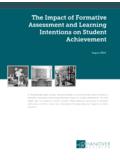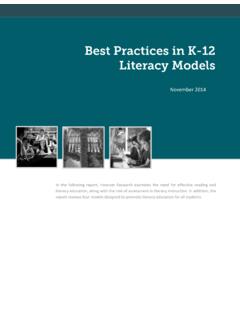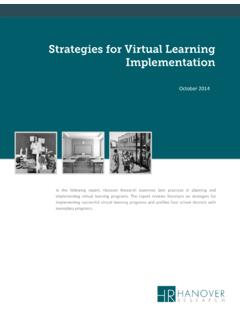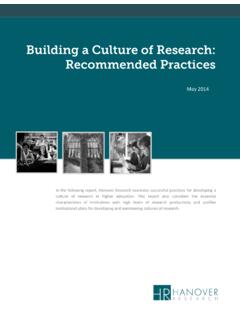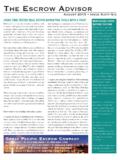Transcription of Trends in Higher Education Marketing, Recruitment, …
1 In the following report, Hanover Research explores a variety of Trends that have developed within Higher Education marketing , enrollment, branding, and recruitment. A close consideration of how technology is impacting Higher Education is also discussed, including emerging Trends in the use of technology to both attract prospective students and boost overall student engagement. Trends in Higher Education marketing , Recruitment, and TechnologyMarch 2014 Hanover Research | March 2014 2014 Hanover Research | Academy Administration Practice2 TABLE OF CONTENTS Executive Summary and Key Findings .. 3 KEY FINDINGS .. 3 Section I: Branding and marketing .. 5 OVERALL Trends .. 5 BRANDING AND marketing STRATEGY.
2 7 SOCIAL AND DIGITAL .. 9 Section II: Recruitment and Enrollment .. 12 RECRUITMENT EFFORTS: COMMON AND EFFECTIVE STRATEGIES .. 13 INTERNATIONAL RECRUITMENT .. 15 ADULT LEARNERS .. 16 CHANGING ADMISSIONS STANDARDS .. 17 Section III: Technology and Higher Education .. 20 ONLINE LEARNING .. 20 CHANGING METHODS OF DELIVERY .. 22 Gamification .. 23 Flipped Classrooms .. 23 Adaptive Learning .. 25 Hanover Research | March 2014 2014 Hanover Research | Academy Administration Practice3 EXECUTIVE SUMMARY AND KEY FINDINGS In the following report, Hanover Research examines recent Trends and developments in Higher Education related to branding and marketing , recruiting and enrollment, and technology. KEY FINDINGS One of the most notable Trends in Higher Education branding and marketing is that institutions are dedicating far more attention to these functions than in previous years.
3 Many universities have hired marketing professionals from the corporate world, including CMOs, and have invested significant time and money to create strong institutional brands. Perhaps the largest area of innovation and growth in Higher Education marketing and branding, as well as in recruitment, is in the online and digital space. Although there is still some doubt that institutions are using technology to its full potential, particularly with social media and other emerging platforms, a recent survey by the University of Massachusetts Dartmouth indicated that nearly 100 percent of institutions polled use some form of social media as part of their marketing and overall operations. Among the most important tools for social and online marketing is an effective and intuitive website, which should be considered the ultimate brand statement for an institution.
4 Websites often feature elements and layouts so as to streamline and highlight content, including navigation bars, engaging visuals such as slideshows, and prominent call to action buttons that encourage students to apply, for example. Despite increased digital activity, a recent survey found that the most effective marketing strategies for universities are nevertheless events based and involve direct interaction with potential students. Radio ads, asking current students or alumni for applicant referrals, and online college fairs were deemed least effective, while the most effective methods of outreach were open houses and campus visit days for high school students. Recruitment strategies in Higher Education increasingly focus on international students and non traditional and adult learners.
5 Colleges and universities in both Canada and the are competing for international students on a growing scale, with Canada increasing its international enrollments by 94 percent over the last decade, and the increasing international enrollments by nearly ten percent over last year. Despite the increase in popularity of online Education , few top tier universities have robust online Education offerings outside of continuing Education programs and MOOC courses. A random sampling of ten institutions in the top 100 Academic Hanover Research | March 2014 2014 Hanover Research | Academy Administration Practice4 Ranking of World Universities (ARWU) showed that only two out of ten offer traditional online courses (non MOOC and non continuing Education ).
6 Newer methods of online and technology enhanced course delivery, including flipped classrooms and gamification, are showing promising student outcomes. Flipped and gamified instruction models in particular have resulted in greater student engagement. Adaptive learning technology has also enjoyed significant interest, and new technologies are currently under development by Fujitsu, MIT, and the Apollo Group. Hanover Research | March 2014 2014 Hanover Research | Academy Administration Practice5 SECTION I: BRANDING AND marketing As universities find the need to appeal to an ever increasing and diverse student base, successful branding and marketing have become increasingly important activities for institutions.
7 Universities must now go to greater lengths to differentiate themselves from competitor institutions. Successful branding can help with increasing enrollment, expanding fundraising capabilities, and other outcomes. A recent Perkins+Will white paper summarized the multi faced nature of branding, and its significance, as follows:1 Today, effective strategic planning and brand management require more than traditional advertising, marketing or identity development. Institutions that craft, present and manage a unified brand message, experience and environment achieve a competitive advantage in recruiting, retaining and building loyalty amongst their students, parents, staff, faculty, alumnae and donors.
8 Communicating a brand successfully to students, both current and prospective, requires strategic planning and effective tools. This section will explore some of the recent ways branding and marketing has been used in the Higher Education industry. OVERALL Trends As indicated above, institutions are focusing on branding and marketing far more than in previous years. Many have hired marketing professionals from the corporate world and invested significant time and money to create strong institutional In some cases such as at Northwestern University in the , this has meant creating Chief marketing Officer (CMO) positions and making brand creation and marketing campaigns a core function of the For some institutions, this sort of re trained perspective and corporate mentality has drawn praise as well as rebuke.
9 Purdue University, for example, spent a half million dollars in 2010 on its "Makers, All" branding campaign which was poorly received by students and However, there is evidence that universities do not have to spend significant amounts of money to be effective. Elliance and other industry experts identify several top Trends from 1 Harnessing the Power of the University Brand: Five Steps to an Effective Branded Facility. Perkins+Will. 2 Kiley, K. A New Brand. Inside Higher Ed, October 4, 2011. ; Armini, M. Beware Higher Ed's 'Mad Men'. Inside Higher Ed, May 27, 2010. 3 Morrison, M. Why Higher Education Needs marketing More Than Ever.
10 Advertising Age, October 22, 2013. strategy/ Higher Education marketing /244820/ 4 Purdue Spent $500K on Controversial Branding Campaign. Inside Higher Ed, June 27, 2011. spent 500k controversial branding campaign Hanover Research | March 2014 2014 Hanover Research | Academy Administration Practice6 2013, and many of these branding and marketing approaches are feasible for most colleges and universities. Unsurprisingly, they are heavily centered on the use of technology:5 Responsive website design: Institutions are placing more emphasis on responsive web design to create intuitive and easy to navigate websites that can be viewed on multiple devices and platforms. Search engine optimization: Administrators want their institutions to receive a prominent spot in search engine results, particularly Google.

